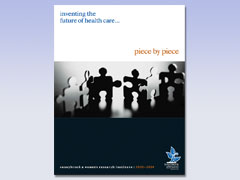Chronic Care
You've been given three wishes to make the world a better place: an end to hunger, global peace and a cure for cancer. Sound good?
It's a beautiful dream. But one of your wishes might be different if cancer didn’t hold the threat of a death sentence.
A cure may not be the only path to a happy ending. What if you could live with cancer for many years by taking drugs with few side effects? That's Dr. Robert Kerbel's dream. He and his team are working to turn advanced cancer into a chronic disease that can be controlled, like diabetes.
Kerbel is passionate about the need to improve quality of life for cancer sufferers. "You just have to walk into a cancer clinic and to see that traditional chemotherapy has very unpleasant side effects. Currently, many patients almost fear the therapy as much as the disease. We have to do a lot better," he says.
Why is a cure so elusive? Well, the same genetic instability that causes cancer cells to grow so wildly also makes them mutate quickly to outwit the latest and greatest cancer drugs, causing drug resistance.
"There are two Holy Grails in treating cancer: to find a therapy that will not be made quickly obsolete by drug resistance and to find drugs that are almost completely safe to take," Kerbel explains.
Tumours grow in part by stimulating the development of new blood vessels, a process called angiogenesis. Kerbel is a pioneer in discovering the mechanisms underlying antiangiogenic treatments, which compromise blood supply totumours. Because the cells that line blood vessels, called endothelial cells, do not mutate like cancer cells, they may not develop drug resistance so readily. Therefore, it is theoretically possible to have an antiangiogenic drug control cancer for many years.
Kerbel's particular specialty is the combination of antiangiogenic drugs with low-dose "metronomic" chemotherapy, the frequent administration of small amounts of traditional chemotherapeutic drugs over an extended period. Antiangiogenic drugs alone are not effective enough, but ongoing clinical trials suggest that the combination strategy shows promise.
Kerbel recently discovered a "marker," a substance that measures the effectiveness of an antiangiogenic drug through simple means, such as a blood test. His research showed that levels of certain types of cells found in the bloodstream that appear to contribute to new blood vessel formation parallel blood vessel growth and can thereby reveal the impact that an antiangiogenic therapy is having on tumours. In other words, if the numbers of these cells go up, the treatment is not stopping angiogenesis; if they go down, it is working.
These markers are vital, Kerbel says, because "you could determine early on whether a drug has a better chance of working before starting long and expensive clinical trials." Kerbel's new marker should help cancer doctors quickly determine the optimal dosage of an antiangiogenic drug, currently a matter of trial and error, to get it into the clinic where it can help patients.
Maybe controlling cancer isn't as thrilling a dream as curing it. But it may actually work.
The National Cancer Institute of Canada/Canadian Cancer Society, the Canadian Institutes of Health Research and the National Institutes of Health (U.S.) funded Kerbel's research. The Canada Foundation for Innovation and the Ontario Innovation Trust provided infrastructure support. He holds a Canada Research Chair in Molecular Biology and Applied Genomics.
PDF / View full media release »





